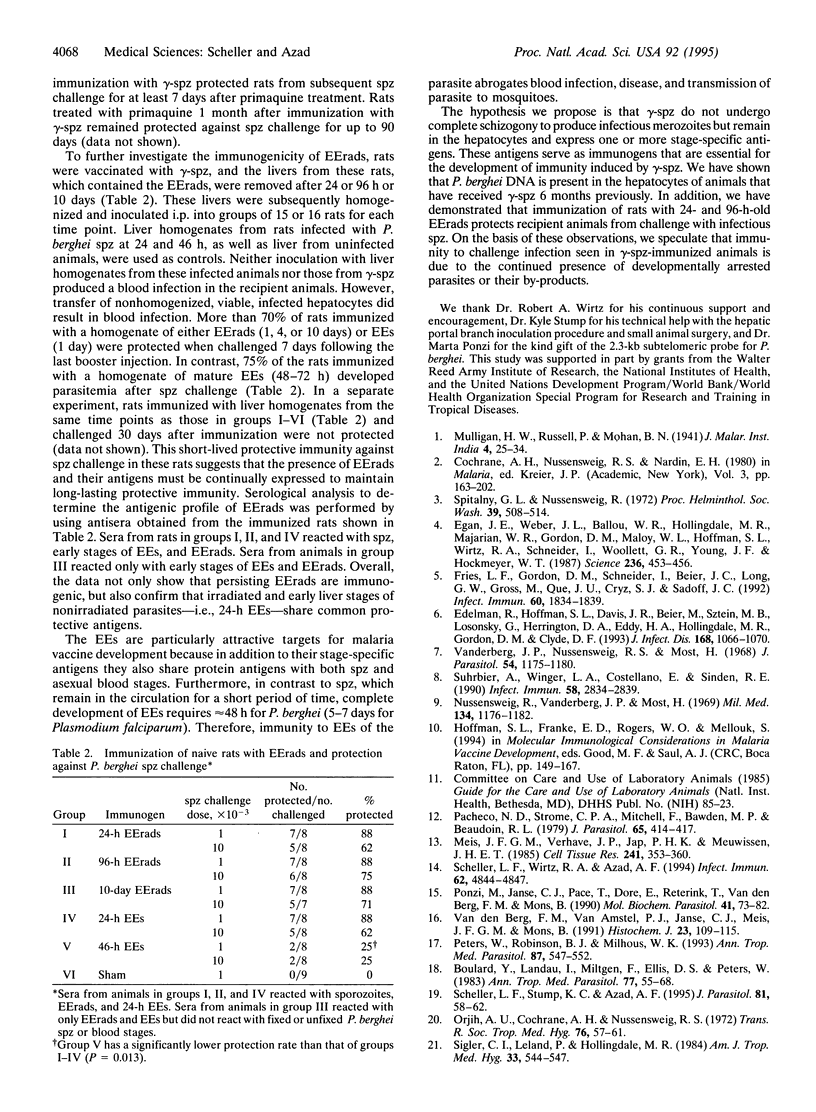Abstract
Immunization of rodents and humans with irradiation-attenuated malaria sporozoites confers preerythrocytic stage-specific protective immunity to challenge infection. This immunity is directed against intrahepatic parasites and involves T cells and interferon gamma, which prevent development of exoerythrocytic stages and subsequent blood infection. The present study was undertaken to determine how protective immunity is achieved after immunization of rodent hosts with irradiated Plasmodium berghei sporozoites. We present evidence that irradiated parasites persist in hepatocytes of rats and mice for up to 6 months after immunization. A relationship between the persistence of parasites and the maintenance of protective immunity was observed. Protective immunity was abrogated in irradiated-sporozoite-immunized rats following the application of chemotherapy to remove preexisting liver parasites. Additionally, protective immunity against sporozoite challenge was established in rats vaccinated with early and late hepatic stages of irradiated parasites. These results show that irradiation-attenuated sporozoites produce persistent intrahepatic stages in vivo necessary for the induction and maintenance of protective immunity.
Full text
PDF


Images in this article
Selected References
These references are in PubMed. This may not be the complete list of references from this article.
- Edelman R., Hoffman S. L., Davis J. R., Beier M., Sztein M. B., Losonsky G., Herrington D. A., Eddy H. A., Hollingdale M. R., Gordon D. M. Long-term persistence of sterile immunity in a volunteer immunized with X-irradiated Plasmodium falciparum sporozoites. J Infect Dis. 1993 Oct;168(4):1066–1070. doi: 10.1093/infdis/168.4.1066. [DOI] [PubMed] [Google Scholar]
- Egan J. E., Weber J. L., Ballou W. R., Hollingdale M. R., Majarian W. R., Gordon D. M., Maloy W. L., Hoffman S. L., Wirtz R. A., Schneider I. Efficacy of murine malaria sporozoite vaccines: implications for human vaccine development. Science. 1987 Apr 24;236(4800):453–456. doi: 10.1126/science.3551073. [DOI] [PubMed] [Google Scholar]
- Fries L. F., Gordon D. M., Schneider I., Beier J. C., Long G. W., Gross M., Que J. U., Cryz S. J., Sadoff J. C. Safety, immunogenicity, and efficacy of a Plasmodium falciparum vaccine comprising a circumsporozoite protein repeat region peptide conjugated to Pseudomonas aeruginosa toxin A. Infect Immun. 1992 May;60(5):1834–1839. doi: 10.1128/iai.60.5.1834-1839.1992. [DOI] [PMC free article] [PubMed] [Google Scholar]
- Meis J. F., Verhave J. P., Jap P. H., Meuwissen J. H. Transformation of sporozoites of Plasmodium berghei into exoerythrocytic forms in the liver of its mammalian host. Cell Tissue Res. 1985;241(2):353–360. doi: 10.1007/BF00217180. [DOI] [PubMed] [Google Scholar]
- Nussenzweig R., Vanderberg J., Most H. Protective immunity produced by the injection of x-irradiated sporozoites of Plasmodium berghei. IV. Dose response, specificity and humoral immunity. Mil Med. 1969 Sep;134(10):1176–1182. [PubMed] [Google Scholar]
- Orjih A. U., Cochrane A. H., Nussenzweig R. S. Comparative studies on the immunogenicity of infective and attenuated sporozoites of Plasmodium berghei. Trans R Soc Trop Med Hyg. 1982;76(1):57–61. doi: 10.1016/0035-9203(82)90019-0. [DOI] [PubMed] [Google Scholar]
- Pacheco N. D., Strome C. P., Mitchell F., Bawden M. P., Beaudoin R. L. Rapid, large-scale isolation of Plasmodium berghei sporozoites from infected mosquitoes. J Parasitol. 1979 Jun;65(3):414–417. [PubMed] [Google Scholar]
- Peters W., Robinson B. L., Milhous W. K. The chemotherapy of rodent malaria. LI. Studies on a new 8-aminoquinoline, WR 238,605. Ann Trop Med Parasitol. 1993 Dec;87(6):547–552. doi: 10.1080/00034983.1993.11812809. [DOI] [PubMed] [Google Scholar]
- Ponzi M., Janse C. J., Dore E., Scotti R., Pace T., Reterink T. J., van der Berg F. M., Mons B. Generation of chromosome size polymorphism during in vivo mitotic multiplication of Plasmodium berghei involves both loss and addition of subtelomeric repeat sequences. Mol Biochem Parasitol. 1990 Jun;41(1):73–82. doi: 10.1016/0166-6851(90)90098-7. [DOI] [PubMed] [Google Scholar]
- Scheller L. F., Stump K. C., Azad A. F. Plasmodium berghei: production and quantitation of hepatic stages derived from irradiated sporozoites in rats and mice. J Parasitol. 1995 Feb;81(1):58–62. [PubMed] [Google Scholar]
- Scheller L. F., Wirtz R. A., Azad A. F. Susceptibility of different strains of mice to hepatic infection with Plasmodium berghei. Infect Immun. 1994 Nov;62(11):4844–4847. doi: 10.1128/iai.62.11.4844-4847.1994. [DOI] [PMC free article] [PubMed] [Google Scholar]
- Sigler C. I., Leland P., Hollingdale M. R. In vitro infectivity of irradiated Plasmodium berghei sporozoites to cultured hepatoma cells. Am J Trop Med Hyg. 1984 Jul;33(4):544–547. doi: 10.4269/ajtmh.1984.33.544. [DOI] [PubMed] [Google Scholar]
- Suhrbier A., Winger L. A., Castellano E., Sinden R. E. Survival and antigenic profile of irradiated malarial sporozoites in infected liver cells. Infect Immun. 1990 Sep;58(9):2834–2839. doi: 10.1128/iai.58.9.2834-2839.1990. [DOI] [PMC free article] [PubMed] [Google Scholar]
- Van den Berg F. M., Van Amstel P. J., Janse C. J., Meis J. F., Mons B. Detection of different developmental stages of malaria parasites by non-radioactive DNA in situ hybridization. Histochem J. 1991 Mar;23(3):109–115. doi: 10.1007/BF01047455. [DOI] [PubMed] [Google Scholar]
- Vanderberg J. P., Nussenzweig R. S., Most H., Orton C. G. Protective immunity produced by the injection of x-irradiated sporozoites of Plasmodium berghei. II. Effects of radiation on sporozoites. J Parasitol. 1968 Dec;54(6):1175–1180. [PubMed] [Google Scholar]



